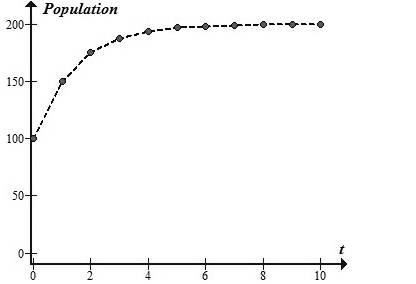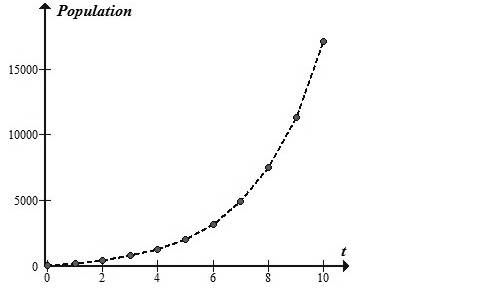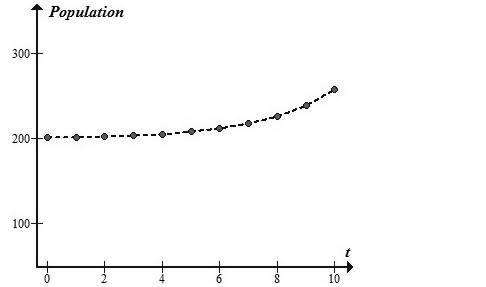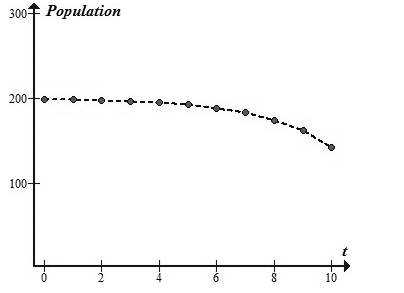
(a)
To find: The graph for the given condition.
(a)
Explanation of Solution
Given:
The equation is,
Calculation:
Let initial be
The population for first generation is,
The population for second generation is,
The population for third generation is,
The population for tenth generation is,
Now,
Plot the graph,

Figure 1
Thus, the graph for the given condition is shown in figure 1.
(b)
To find: The graph for the given condition.
(b)
Explanation of Solution
Given:
The equation is,
Calculation:
Let initial be
The population for first generation is,
The population for second generation is,
The population for third generation is,
The population for tenth generation is,
Now,
Plot the graph,

Figure 2
Thus, the graph for the given condition is shown in figure 2.
(c)
To find: The graph for the given condition.
(c)
Explanation of Solution
Given:
The equation is,
Calculation:
Let initial be
The population for first generation is,
The population for second generation is,
The population for third generation is,
The population for tenth generation is,
Now,
Plot the graph,

Figure 3
Thus, the graph for the given condition is shown in figure 3.
(d)
To find: The graph for the given condition.
(d)
Answer to Problem 49E
The graph for the given condition is shown in figure 4.
Explanation of Solution
Given:
The equation is,
Calculation:
Let initial be
The population for first generation is,
The population for second generation is,
The population for third generation is,
The population for tenth generation is,
Now,
Plot the graph,

Figure 4
Thus, the graph for the given condition is shown in figure 4.
(e)
To find: The model when run for 15 steps.
(e)
Answer to Problem 49E
After fifteen steps, the value becomes negative.
Explanation of Solution
Given:
The equation is,
Calculation:
The population for fifteenth generation is,
Now,
Thus, after fifteen steps, the value becomes negative.
Want to see more full solutions like this?
Chapter 1 Solutions
Modeling the Dynamics of Life: Calculus and Probability for Life Scientists
- d((x, y), (z, w)) = |xz|+|yw|, show that whether d is a metric on R² or not?. Q3/Let R be a set of real number and d: R² x R² → R such that -> d((x, y), (z, w)) = max{\x - zl, ly - w} show that whether d is a metric on R² or not?. Q4/Let X be a nonempty set and d₁, d₂: XXR are metrics on X let d3,d4, d5: XX → R such that d3(x, y) = 4d2(x, y) d4(x, y) = 3d₁(x, y) +2d2(x, y) d5(x,y) = 2d₁ (x,y))/ 1+ 2d₂(x, y). Show that whether d3, d4 and d5 are metric on X or not?arrow_forwardJu at © Ju 370 = x (- пье zxp = c² (2² 4 ) dx² ахе 2 nze dyz t nzp Q/what type of partial differential equation (PDE) are the following-arrow_forwardQ Calculate the Fourier series for f(x) = x on the interval -16≤x≤ Tarrow_forward
- Find all positive integers n such that n.2n +1 is a square.arrow_forwardA straight-line H is tangent to the function g(x)=-6x-3+ 8 and passes through the point (- 4,7). Determine, the gradient of the straight-line Choose.... y-intercept of the straight-line Choose... + which of the following is the answers -1.125 -6.72 1.125 7.28 0.07 - 7.28 6.72arrow_forwardYou are required to match the correct response to each statement provided. Another term/word that can be used synonymously to Choose... gradient. A term/phrase that is associated with Arithmetic Progression. Common difference → An identity matrix can be referred to as a Choose... ÷ What is the inequality sign that represents "at most"? VIarrow_forward
- Algebra & Trigonometry with Analytic GeometryAlgebraISBN:9781133382119Author:SwokowskiPublisher:Cengage
 Linear Algebra: A Modern IntroductionAlgebraISBN:9781285463247Author:David PoolePublisher:Cengage Learning
Linear Algebra: A Modern IntroductionAlgebraISBN:9781285463247Author:David PoolePublisher:Cengage Learning College AlgebraAlgebraISBN:9781305115545Author:James Stewart, Lothar Redlin, Saleem WatsonPublisher:Cengage Learning
College AlgebraAlgebraISBN:9781305115545Author:James Stewart, Lothar Redlin, Saleem WatsonPublisher:Cengage Learning  Algebra and Trigonometry (MindTap Course List)AlgebraISBN:9781305071742Author:James Stewart, Lothar Redlin, Saleem WatsonPublisher:Cengage Learning
Algebra and Trigonometry (MindTap Course List)AlgebraISBN:9781305071742Author:James Stewart, Lothar Redlin, Saleem WatsonPublisher:Cengage Learning Elementary Linear Algebra (MindTap Course List)AlgebraISBN:9781305658004Author:Ron LarsonPublisher:Cengage Learning
Elementary Linear Algebra (MindTap Course List)AlgebraISBN:9781305658004Author:Ron LarsonPublisher:Cengage Learning Algebra for College StudentsAlgebraISBN:9781285195780Author:Jerome E. Kaufmann, Karen L. SchwittersPublisher:Cengage Learning
Algebra for College StudentsAlgebraISBN:9781285195780Author:Jerome E. Kaufmann, Karen L. SchwittersPublisher:Cengage Learning





